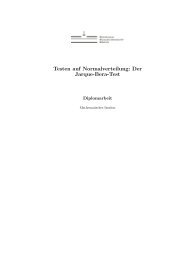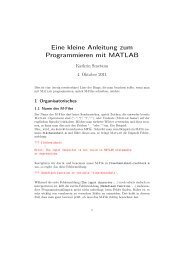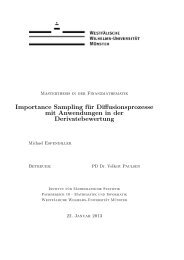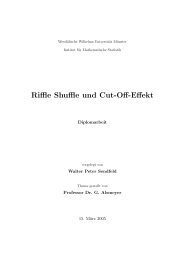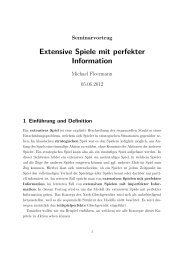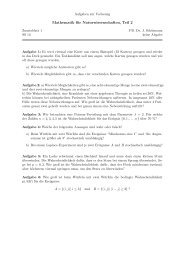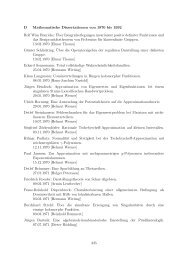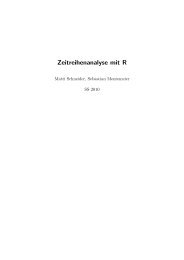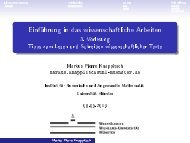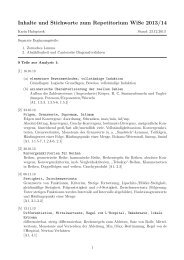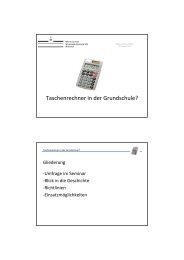Margulis Lemma
Margulis Lemma
Margulis Lemma
Create successful ePaper yourself
Turn your PDF publications into a flip-book with our unique Google optimized e-Paper software.
STRUCTURE OF FUNDAMENTAL GROUPS 21<br />
Moreover, a lift ˜f new,i : λ i ˜Mi → λ i ˜Mi of f new,i has the zooming in property, too.<br />
Since g i can be chosen isotopic to the identity, the action of ˜fnew,i on the deck<br />
transformation group Z pi = π 1 (B i ) by conjugation remains unchanged.<br />
On the other hand, the Z pi -action on ˜M i converges to a discrete Z-action on<br />
R 2 and ˜f new,i converges to an isometry ˜f new,∞ of R 2 normalizing the Z-action.<br />
This implies that ˜f new,∞ 2 commutes with the Z-action and it is then easy to get a<br />
contradiction.<br />
Problem. We suspect that for any given n and D only finitely many of the groups<br />
in the above family of groups should occur as fundamental groups of compact n-<br />
manifolds with Ric > −(n − 1) and diameter ≤ D. Note that this is not even<br />
known under the stronger assumption of K > −1 and diam ≤ D.<br />
5. The Rescaling Theorem.<br />
Theorem 5.1 (Rescaling Theorem). Let (M, g i , p i ) be a sequence of n-manifolds<br />
satisfying Ric Bri (p i) > −µ i and B ri (p i ) is compact for some r i → ∞, µ i → 0.<br />
Suppose that (M, g i , p i ) → (R k , 0) for some k < n. Then after passing to a subsequence<br />
we can find a compact metric space K with diam(K) = 10 −n2 , a sequence<br />
of subsets G 1 (p i ) ⊂ B 1 (p i ) with vol(G1(pi))<br />
vol(B → 1 and a sequence λ 1(p i)<br />
i → ∞ such that<br />
the following holds<br />
• For all q i ∈ G 1 (p i ) the isometry type of the limit of any convergent subsequence<br />
of (λ i M i , q i ) is given by the metric product R k × K.<br />
• For all a i , b i ∈ G 1 (p i ) we can find a sequence of diffeomorphisms<br />
f i : [λ i M i , a i ] → [λ i M i , b i ]<br />
with the zooming in property such that f i is isotopic to the identity. Moreover,<br />
for any lift ã i , ˜b i ∈ ˜M i of a i and b i to the universal cover ˜M i we can<br />
find a lift ˜f i of f i such that<br />
˜f i : [λ i ˜Mi , ã i ] → [λ i ˜Mi , ˜b i ]<br />
has the zooming in property as well.<br />
Finally, if π 1 (M i , p i ) is generated by loops of length ≤ R for all i, then we can<br />
find ε i → 0 such that π 1 (M i , q i ) is generated by loops of length ≤ 1+εi<br />
λ i<br />
for all<br />
q i ∈ G 1 (p i ).<br />
Proof. By Theorem 1.3, after passing to a subsequence we can find a harmonic map<br />
b i : B i (p i ) → B i+1 (0) ⊂ R k that gives a 1 2<br />
Gromov–Hausdorff approximation from<br />
i<br />
B i (p i ) to B i (0) ⊂ R k . Put<br />
h i =<br />
k∑<br />
| < ∇b i j, ∇b i l > −δ j,l | + ∑ j<br />
j,l=1<br />
‖Hess b i<br />
j<br />
‖ 2 .<br />
After passing to a subsequence we also have by Theorem 1.3 that<br />
∫<br />
− h i ≤ ε 4 i for all R ∈ [1, i] with ε i → 0.<br />
B R (p i)<br />
Furthermore, we may assume Ric > −ε i on B i (0).<br />
(10) G 4 (p i ) := { x ∈ B 4 (p i ) | Mx h i (x) ≤ ε 2 i<br />
}<br />
.



